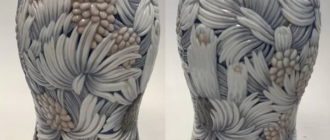
Höchst porcelain has been produced since 1746 in the eponymous district of Frankfurt am Main. The Hoechst manufactory is one of the oldest not only in Germany, but throughout Europe. Its brand is a wheel borrowed from the coat of arms of the city of Mainz, which is applied under glaze with cobalt paint. Both in the 18th century and today, Hoechst porcelain is painted by hand. It is distinguished by the highest quality and aesthetics – it is a worthy decoration of a noble house and a valuable find for a collector.

The history of Höchst porcelain
Hoechst porcelain began to be produced on the initiative of the Elector of Mainz, Johann Karl von Ostein. The factory was founded in 1746 by the entrepreneur Johann Christoph Göltz and the artist of the Meissen manufactory, Adam Friedrich von Löwenfinck. The first few years of experiments with porcelain were unsuccessful, and the factory produced faience with a dark shard. Chemist Johann Benckgraff helped to establish the production of high-grade hard porcelain in 1750.
Porcelain Hoechst was created by the best painters and sculptors of their time – many of them had experience of working at other famous manufactures in Germany. The factory gained wide popularity under Laurent Russinger, but Johann Peter Melchior, who came later, is considered its best model master.

In the 18th century, the manufactory worked for 50 years, periodically changing owners and forms of management. During this time, she repeatedly faced financial difficulties, and after the occupation of Mainz during the French Revolutionary Wars, the factory was closed. In 1796, she was officially declared bankrupt, and all forms and models were auctioned off. Subsequently, they were successfully used by other manufacturers.
The half-century work of the Hoechst manufactory left a noticeable mark in the history of artistic ceramics, so that in the 20th century it was not forgotten. In 1946, an exhibition dedicated to the 200th anniversary of the famous brand took place. A year later, the factory was revived and continues to work in our time. She produces table and decorative porcelain, which is hand-painted by artists, just like 270 years ago. The most famous masters of modern times are Marietta Freyer and Kurt Schröder. Antique specimens can be seen in the Museum of Frankfurt am Main and in many other leading collections in Europe and the United States. Some of the exhibits are on display in the Hermitage.
What is Hoechst porcelain famous for?
Craftsmen came to this manufactory from other factories, including Meissen and Frankenthal. After several years of work, having gained new experience, they left again in search of a better place. Thus, the products of the factory have absorbed all the best that was in the German porcelain production of the 18th century. Items were designed mainly in the Rococo style, which was then at the peak of its popularity. Here are the most famous Höchst porcelain products:
Figures of the characters of the Italian comedy. The factory produced different sets of characters from the commedia dell’arte. The best are the products of Ludwig von Lücke, which stand on a high base.
Sculptures by Johann Peter Melchior. The most famous sculptural group created by this master in Höchst is “The Audience of the Chinese Emperor”.
Rococo sculpture based on prints and paintings. For example, “Amyntas Free Sylvia” based on the painting by François Boucher.
Serving utensils depicting animals and birds. For example, a terrine in the shape of a boar’s head or a tureen in the shape of a woodcock.
Buying Höchst porcelain
Both old and later products of this manufactory are beautiful and executed with exquisite taste. Many collectors dream of purchasing such antiques. Items of the 18th century are a museum rarity, they are almost never found on sale. But you can buy a figurine and crockery of the 20th century or earlier products from other factories, made according to the Hoechst shapes.
To find a replenishment for the collection, you need to regularly visit antique stores and hope for good luck. But there is a more reliable and convenient way: these are thematic auctions that are regularly held on the Very Important Lot website. Antique masterpieces from Russia and Europe are exhibited at the auction, you can buy them at an affordable price.






















